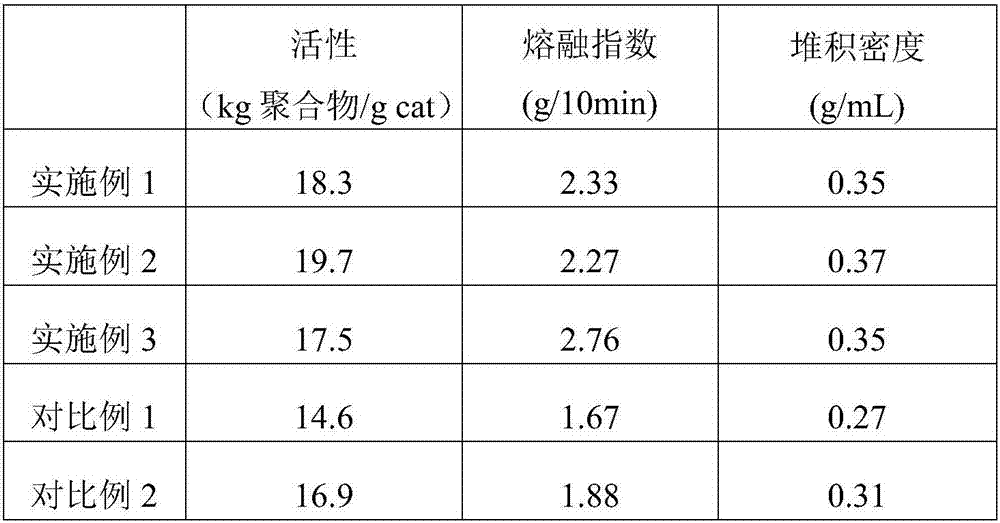Catalyst component for olefin polymerization and preparation method and catalyst thereof
A technology for olefin polymerization and catalyst, which is applied to the catalyst component of olefin polymerization and the preparation method thereof and the field of catalyst, can solve the problems of complex forming steps, affecting the shape of catalyst particles, difficult to control, etc., and achieves good hydrogen regulation performance and good particle shape. and distribution effect
- Summary
- Abstract
- Description
- Claims
- Application Information
AI Technical Summary
Problems solved by technology
Method used
Image
Examples
Embodiment 1
[0048] Take 30mL of hexane, 3.15mL of dibutylmagnesium hexane solution (1M) and 1.0mL of iso-octanol in sequence, raise the temperature to 50°C and keep stirring for half an hour to obtain a transparent solution, then add polybutadiene block polyformaldehyde Methyl acrylate copolymer (polybutadiene content 33wt%) hexane solution (10g / L) 2mL, cool to -50 ℃, add 0.6ml phosphorus trichloride and 0.35mL titanium tetrachloride successively, add After feeding, the temperature was rapidly raised to 50° C. within 10 minutes, and the reaction was maintained for 2 hours. The temperature of the catalyst suspension was lowered to room temperature, allowed to stand, settled, washed three times with hexane, each time the amount of hexane was 50 milliliters, and after the washing was completed, it was dried to obtain a brown solid fluid powder with an average particle size of 26.8 microns.
[0049] Elemental analysis (ICP): Ti: 8.33% by weight, Mg: 16.10% by weight.
[0050] Ethylene polyme...
Embodiment 2
[0052] Add polybutadiene block polymethyl methacrylate copolymer (polybutadiene content 33wt%) hexane solution (10g / L) 2mL in catalyst preparation process, add polybutadiene block polymethylmethacrylate instead Methyl methacrylate copolymer (polybutadiene content 33wt%) hexane solution (10g / L) 4mL, change the phosphorus trichloride of 0.6 milliliter into the phosphorus oxychloride of 0.6 milliliter simultaneously, other conditions are with embodiment 1. The average particle size of the catalyst component is 15.3 microns.
[0053] Elemental analysis (ICP): Ti: 8.98% by weight, Mg: 16.21% by weight.
[0054] The ethylene slurry polymerization evaluation conditions of the catalyst are the same as in Example 1, and the polymerization results are shown in Table 1.
Embodiment 3
[0056] Change the 1.0mL isooctyl alcohol in the catalyst preparation process to 3.0mL isooctyl alcohol, quickly raise the temperature to 50°C within 10 minutes, then change the temperature to naturally and slowly rise to room temperature, and then heat to 50°C. Other conditions are the same as in Example 1. The average particle size of the catalyst components was 20.4 microns.
[0057] Elemental analysis (ICP): Ti: 10.51% by weight, Mg: 17.29% by weight.
[0058] The ethylene slurry polymerization evaluation conditions of the catalyst are the same as in Example 1, and the polymerization results are shown in Table 1.
PUM
 Login to View More
Login to View More Abstract
Description
Claims
Application Information
 Login to View More
Login to View More - R&D
- Intellectual Property
- Life Sciences
- Materials
- Tech Scout
- Unparalleled Data Quality
- Higher Quality Content
- 60% Fewer Hallucinations
Browse by: Latest US Patents, China's latest patents, Technical Efficacy Thesaurus, Application Domain, Technology Topic, Popular Technical Reports.
© 2025 PatSnap. All rights reserved.Legal|Privacy policy|Modern Slavery Act Transparency Statement|Sitemap|About US| Contact US: help@patsnap.com

